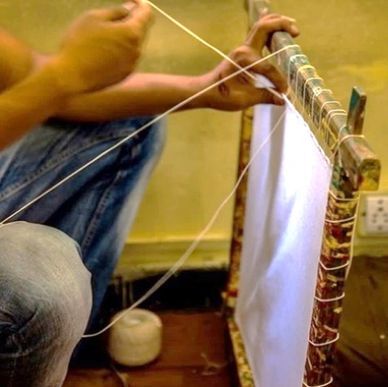How to paint a Thangka?
Canvas Preparation
Shading and Coloring
Canvas Preparation

The canvas for Thangka painting is prepared by the artist and must follow specific steps carefully, as its quality is just as important as any other aspect of the painting. The steps to prepare a canvas are as follows:
- Cut a piece of cotton to the desired size and sew all four sides, leaving holes at the corners for stringing.
- Stretch the sewn cloth tightly on a wooden or metal frame, securing each corner with a strong string.
- Prepare a medium-thick mixture of water, white clay, and glue, and apply it evenly on both sides of the cloth. Allow it to dry completely.
- Moisten a section of the dried canvas with wet cotton, then gently rub it with a smooth stone. Repeat this process over the entire surface until the canvas achieves the desired smoothness.
- Ensure the surface is perfectly smooth, as this is essential for the subsequent painting process.
Sketch
Shading and Coloring
Canvas Preparation

Once the canvas is prepared, the artist begins by sketching the outline of the chosen deity, mandala, or other sacred motif. This preliminary sketch serves as the blueprint for the painting, ensuring accurate proportions, alignment, and placement of symbolic elements in accordance with traditional iconography.
Precision is essential at this stage, as Thangka art follows strict rules for symmetry, scale, and iconographic accuracy. Artists typically use fine pencils to draw light, easily adjustable lines.
The image shown here illustrates a preliminary sketch of a Mandala. Once the sketch is finalized, the artist proceeds to the next stage: applying the base colors and shading—or vice versa—to bring the sacred image to life.
Shading and Coloring
Shading and Coloring
Che and Marche(Outlining)

In this stage, colors are applied to create a gradation of the landscape — shading the sky, land, clouds, flowers, leaves, rocks, and other elements. Achieving this gradation is a repetitive and time-consuming process. The remaining areas of the Thangka are then painted with the appropriate colors.
Traditionally, pigments extracted from plants and minerals were used, but nowadays, commercially available paints are often used for convenience.
Che and Marche(Outlining)
Che and Marche(Outlining)
Che and Marche(Outlining)

After the base colors and shading, the artist outlines the central figure’s robe, ornaments, and sacred objects, leaving the face and body for later. Surrounding elements such as flowers, clouds, and mountains are also outlined to define the composition.
Fine brushes are used to ensure precision, as even small lines contribute to the symmetry, balance, and sacred symbolism of the Thangka. This stage prepares the painting for final detailing, highlights, and gold accents.
Gold Painting
Che and Marche(Outlining)
Face and Body Painting
In Thangka painting, pure 24-carat gold dust is carefully applied using fine brushes or traditional tools, requiring precision and patience to preserve the delicate details of the design. Gold not only enhances the visual richness of the Thangka but also carries symbolic significance, representing purity, enlightenment, and sacred energy. It is generally applied to the deity’s robe, shrine, ornaments, and carried objects, though it may also appear on leaves, rocks, and other decorative details.
Face and Body Painting
Che and Marche(Outlining)
Face and Body Painting

This stage marks the near-end of the painting process. The first task is Kumje, which involves defining the correct body proportions and posture of the deity or deities. This is followed by Kumje of the facial features, where the expressions and characteristics are carefully outlined. Once the body and face are properly defined, the shading of the body begins in a process known as Syamtang, which adds depth, volume, and a lifelike appearance to the figure. Precision and subtlety are crucial at this stage, as even minor errors can affect the overall harmony of the Thangka.
After all major work is complete, a thorough final review is conducted to ensure that proportions, colors, details, and symbolic elements are accurate, preserving the sacred and artistic integrity of the painting.
Gold Polishing
In this step, the 24-carat gold applied to the Thangka is carefully polished using a pointed shi (a smooth stone from the Himalayas) or glass of various sizes, selected according to the design or pattern. This step may be omitted if desired
Silk Brocade Framing (optional)

Traditionally, Thangkas are mounted on a silk brocade frame, allowing them to be hung as desired. This design also makes them easy to roll up, making them convenient for travel. For display purposes, Thangkas can alternatively be framed under glass. Since silk brocade framing is optional, we prepare a Thangka in this manner only upon request. Please contact us before making your final payment if you have any questions regarding silk framing.